Final report for FNE18-902
Project Information
No-till renovation of cranberry bogs can be a revolutionary method of changing cranberry varieties in a sustainable method utilizing fewer resources and requiring substantially less capital investment. The project included two distinct plots applying different methods of testing no-till transplanting of rooted plugs into existing cranberry turf with little to no disturbance of the exiting soil structure. Similar to traditional no-till we killed off the existing vegetation (cranberry vines) and mowed the vines with flail mower. The existing irrigation system was preserved with no alteration. The 5 year average off these plots was 129 bbl/acre. Rooted cuttings of a new cranberry variety called Crimson King from Valley Corp in Tomah, WI were planted using a transplanter. According to Valley Corp., yields for Crimson King range from 600-900bbl/acre producing a firm berry with uniform coloring throughout canopy.
The project proved that no-till can work with several modifications to the transplanter to ensure proper soil contact of the rooted cutting. Using Glyphosate applications were important to successfully kill off the existing vine and we did not witness any regrowth of the old variety. This was a critical aspect in maintaining varietal purity and ultimately productivity of the bed. The final cost of the renovation was 1/3 of that of conventional bog renovation. I am convinced with proper Nitrogen fertilization you can achieve the same vine growth and achieve full production within the same time period as traditional renovation, but that will only be proven 2 years after the end of this contract.
The outreach for this project included onsite bog tours, presentation of the project at the annual UMass cranberry research update meeting and publication of an article in the UMass Cranberry Station Newsletter.
The main purpose of this project was to evaluate a completely new method of renovating cranberry farms by employing technology utilized in other sectors of agriculture. No one had ever tried planting rooted cranberry cuttings with a no-till transplanter. Cranberry growers have only used a traditional transplanter, going into in a deep clean sand surface. As with no-till in conventional crops, adoption must be preceded by a change in the ‘mind set’ that the soil surface must be clean and free of residue. This on-farm research and demonstration project provided real-life results that can be showcased and replicated in the grower community.
No-till transplanting is a viable method of changing varieties for growers, it can revolutionize the renovation of cranberry bogs. It will reduce the resource intensity of sand use and excavation of soil that comes with traditional renovation. It will reduce renovation costs by as much as 75 percent per acre.
Cranberries are the number one food crop in MA with a $69 million farm gate value, supporting more than 60,000 acres of open space and providing over 6,900 jobs. Over 60 percent of the nearly 400 cranberry growers produce on no more than 20 acres, making the industry made up of many individual small family farms. Cranberries are economically important to the state and the region; however, many Massachusetts cranberry bogs are still producing on the same vine/varieties that were planted over 100 years ago. Cranberry growers who wish to remain profitable must renovate their older producing acreage to more high-yielding large-fruited varieties. This will not only improve yields, but will allow growers to produce the specific type of berries needed to grow the market. Roughly fifty percent of the planted acreage in Massachusetts is native small fruit varieties which are low yielding and have limited utilization in the marketplace. The manufacturing of sweeten dried cranberries, a targeted segment of the marketplace, requires a specific size and quality of fruit produced by the newer hybrids varieties. Renovation is both a resource and capital intensive process. Traditional renovations involve removing the existing vine and soil, creating a disposal challenge for the volume of soil in excess of 1,000-2,000 cubic yards per to be removed. New layer of sand (a nonrenewable resource) is applied at a depth of 6-10” using roughly 1,100 cubic yards of sand per acre, at a cost of almost $14,300 per acre (includes transportation costs). Sand has historically been used as a propagation medium for traditional vine cuttings, but is questionable if needed for rooted cuttings that I am using in this project. If sand is available on-site, it can still cost $5,000 per acre to screen and spread. Additionally growers will replace the irrigation system as a result of damage caused by the construction activities in the renovation process, at a cost of $2,000-3,000 per acre.
My project will evaluate two innovative techniques that may offer an approach that is not so disruptive to the environment or destroy the soil microorganisms, does not require the heavy use of limited sand resources, is cost effective and will provide an important tool to promote the long term economic results required for cranberry farms to be remain viable.
Cooperators
- - Technical Advisor
Research
The project set out to determine if no-till renovation was possible from a mechanical, horticultural and economic perspective. The project took place on 2 plots of roughly equal size. One consisted of the variety Howes and the second a vigorous vegetative variety called Whiting Randell’s. Total area of project was .93 acre. One plot was treated as a true no-till with no soil alteration, the second plot (sand plot) was treated similarly to the first except we spread 2-3" of sand on top of the cranberry turf after mowing the vines.
In consultation with my advisor we evaluated using a few different options to kill off the existing vegetation. Glyphosate was ultimately chosen for its broad spectrum kill and ability to translocate throughout plant. A main concern was that we did not want to experience any regrowth of the old cranberry varieties which would jeopardize the purity of the bed if it contained more than one variety.
The first step in the project was to kill the existing cranberry vines and weeds. We sprayed the plots with Glyphosate on May 9, 2018. Our Advisor made a site visit on May 14 to discuss the effectiveness and to trouble shoot why we did not experience the dieback expected. There was some cooler then average weather following the application which slowed the effectiveness of the spray. We began to see dieback on the 10-14days following application. A second Glyphosate application was made on May 23, 2019, this was followed by warmer than normal temperatures and the plots died back very quickly.
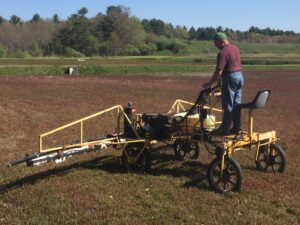
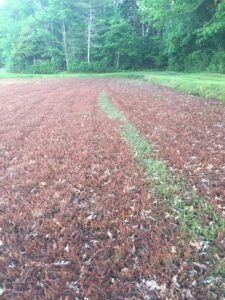
I mowed the first plot of Howe variety on June 6 with a traditional flail mower. The result created a perfect bed of mulch that could easily transplant through. The vines were mowed to about 2 inches above the soil and mower pulverized the dead vines leaving little residue. The plot that contained the Randell Vines was more of a challenge as the Randell vines where extremely thick. On June 12 we had a local farmer come in with a traditional hay mower to mow the Randell plot. The vine was extremely thick and had to be windrowed and physically removed from the bog. We did not weigh the volume of materials but was estimated to be about 4 tons. In perfect conditions these vines would have been baled with a hay baler for easy removal, but because of the plot size we had to mechanically remove them with a thumb on the front of a loader which created a lot of disturbance of the soil. Fortunately this was the plot we intended to use as a sand plot and we were able to regrade the plot with sand. In both plots we reused the existing irrigation system without any modification. The aboveground sprinkler heads were removed to facilitate the use of equipment. Following planting the sprinklers were reinstalled using existing quick couplers typically found in cranberry operations.
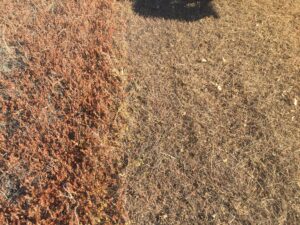
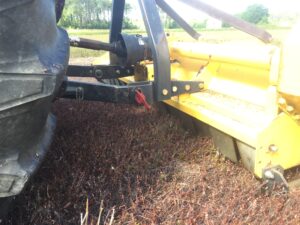
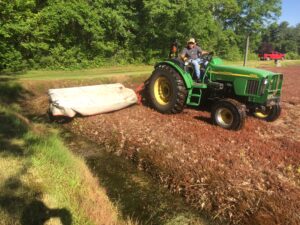
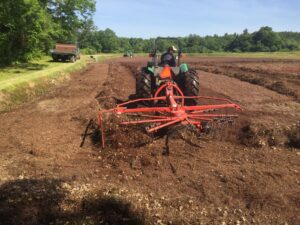
The rooted plugs arrived on June 6. Planting of the Howe plot commenced on June 11 and was completed on June 13. After the vine removal on the Randell we hauled sand to the plot and spread about 2-3 inches over the vine stubble. The sand was spread with a tracked skid steer. We planted the Randell plot June 19-20.
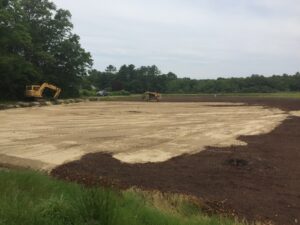
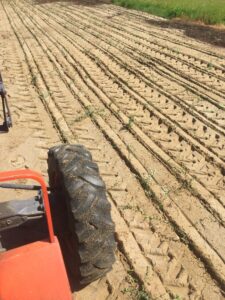
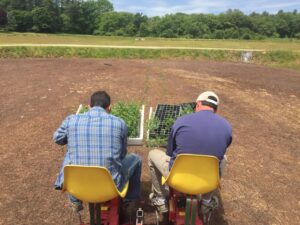
The plots were fertilized every 7-10 days with granular fertilizer. A season total of 130lbs of nitrogen, 58 pounds of phosphorus and 114 pounds of Potassium were applied over a 10 week period of time following planting. We measured vine runner growth of the plantings at the end of the growing season. A noticeable difference was observed between the sand plot and the mowed plot. The sand plot had vine growth in excess of 12", where as the mowed plot had strong upright growth in excess of 8", however had no to little runner growth, which is typically a sign of needing more nitrogen.
During the winter the plots were flooded to form a protective layer of ice over the vines, which will prevent desiccation from the winter conditions. Once a layer of ice formed we were able to spread about 1 inch of sand on the ice that covered the sand plot. In the spring the sand will sift into the cranberry vines to bury the runner growth from the following year. This will stimulate root development and upright growth from the runners. Unfortunately the ice conditions deteriorated quickly and we were unable to sand the mowed plot and thus will have to sand that plot in the spring by driving directly on the plugs to spread the 1" of sand. It is the industry standard to sand on ice in order to prevent damage caused by driving directly on the vines with a sander.
Mechanical: There is a need to make some slight modifications to a transplanter to properly place the rooted cutting. First I would attach a pre-slice coulter that would cut the turf layer at least 6 inches in front of the coulters that open the turf. Second the wheels that close the furrow need additional down pressure to insure the furrow is properly closed to maintain soil contact with the rooted cutting.
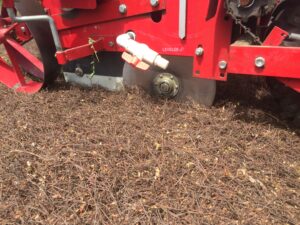
Transplanter coulter slicing through turf.
Horticultural: I clearly saw a difference in the plant growth response in the true No-till without sand applied verse the plot that had 2-3” of sand applied. The sanded plots responded to nitrogen fertilizer quicker and developed runner growth exceeding the non-sanded plot. I hypothesize that the woody material that was left behind from the old vines may have depleted nitrogen as it was degraded through the soil microorganisms. I did not account for this in my fertilizer applications. I would suggest that nitrogen needs to be increased above Extension recommendations for normal sand plantings. I adjusted nitrogen levels towards the end of the season, but it was too late to achieve optimum growth. I expect to see vigorous growth the second year.
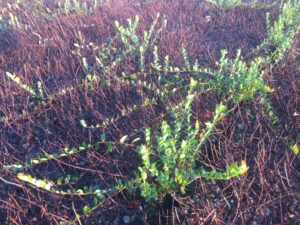
Strong upright growth and some lateral growth of no-till plugs
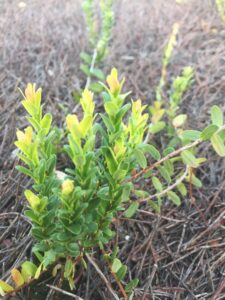
Possible nitrogen deficiency with yellowing vine tips.
Weed control of perennial weeds also created a challenge. We had reemergence of poison ivy, poverty grass, running bramble and saw brier. The saw brier reemergence was in perfect rows through the slices made by the coulter of the transplanter. One option for bogs with significant perennial weeds is to conduct the kill off the prior fall after harvest or even take a crop loose the prior year by killing off all vegetation a year prior to the actual planting. This of course impacts the economic model as you would lose an additional year of crop, so would have to be taken in account. Another option is to be more aggressive with selective herbicide applications during the first growing season.
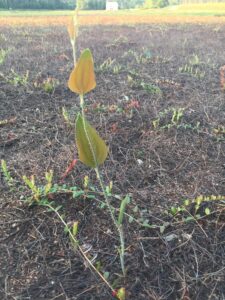
Saw Brier emerging from sliced turf left by transplanter.
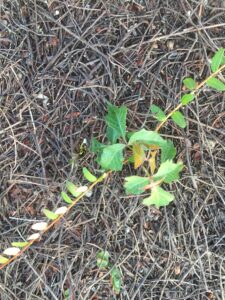
Poison Ivy reemergence
Maintain Varietal Purity: The Glyphosate applications did successfully kill off the existing vine and we did not witness any regrowth of the old variety. This was a critical aspect in maintaining varietal purity and ultimately productivity of the bed.
Economics: The final cost of the renovation was 1/3 of that of conventional renovation. I am convinced with proper fertilization you can achieve the same vine growth and achieve full production within the same time period as traditional renovation, but that will only be proven 2 years after the end of this contract.
No-till transplanting for bog renovation can mechanically be done with minor transplanter modifications.
Two farmers including myself and another grower in Kingston, MA both implemented the no-till method or a variation of the no-till. The both us agree that this method is economically feasible and would implement this method on a broader scale in future renovation projects. I strongly believe that other growers would implement this method once they see the results over a longer period of time that eclipses the time period of this specific grant project.
Education & Outreach Activities and Participation Summary
Participation Summary:

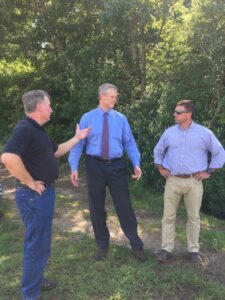
Many of our tours happened by word of mouth, that spread like a wildfire. Our home overlooks the bog we conducted the project on. While in my home I would suddenly see someone walking around the bog. Often it was a grower who had heard about the project and wanted to stop by to see what I was up to. I conducted about a twenty tours with growers including 2 out of state growers who travelled from WI and RI to see the project.
I conducted tours for the Ag Scientist at Ocean Spray Cranberries who want to understand the application. Ocean Spray’s sustainability manager also came to see how the project worked and wishes to conduct further studies on the carbon sequestration this type of renovation could result in verse a traditional renovation.
I had 5 growers stop by to see the actual transplanting while it was happening and even volunteering to sit on the transplanter to experience it firsthand.
In mid-August the MA Commissioner of Agriculture had contacted me about hosting a tour for the Governor to see how innovation can be applied in the cranberry industry. I conducted site visit for Commission of Agricultural Resources John Lebeaux, Secretary of Energy and Environmental Affairs Matthew Beaton and Governor Charlie Baker. The Governor had recently signed an Environmental Bond Bill which contained funding for an Agricultural Innovation Center which would seed projects like this.
I developed a powerpoint presenation on the project that was presented by Dr. Hilary Sandler at the UMass Cranberry Station extension update on January 30. This event had 180 growers, employees and cranberry research and extension personnel in attendance. Additional I wrote an article for the March 2019 issue of the UMass Cranberry Station Newsletter which was emailed to 94 people and hardcopies mailed to an additional 102 people.
UMass-Cranberry-Station-March-2019-Newsletter
Project-PowerPoint-for-UMass-Cranberry-Update-Meeting-Janulary-30-2019
Learning Outcomes
The level of changes in knowledge and awareness was based on the participants direct or indirect exposure to the project. Two of the participants experienced the changes listed below based on their direct involvement in conducting the project. The balance provided verbal affirmation that the method held promise and would consider implementing on their own personal farms.
Mechanical: There is a need to make some slight modifications to a transplanter to properly place the rooted cutting.
Horticultural: I clearly saw a difference in the plant growth response in the true No-till without sand applied verse the plot that had 2-3” of sand applied. The sanded plots responded to nitrogen fertilizer quicker and developed runner growth exceeding the non-sanded plot. Weed control of perennial weeds also created a challenge. We had reemergence of poison ivy, poverty grass, running bramble and saw brier.
Maintain Varietal Purity: The Glyphosate applications did successfully kill off the existing vine and we did not witness any regrowth of the old variety. This was a critical aspect in maintaining varietal purity and ultimately productivity of the bed.
Economics: The final cost of the renovation was 1/3 of that of conventional renovation. I am convinced with proper fertilization you can achieve the same vine growth and achieve full production within the same time period as traditional renovation, but that will only be proven 2 years after the end of this contract.
Project Outcomes
No-till transplanting for bog renovation can mechanically be done with transplanter modifications I mentioned above.
Two farmers including myself and another grower in Kingston, MA both implemented the no-till method or a variation of the no-till. The both us agree that this method is economically feasible and would implement this method on a broader scale in future renovation projects. I strongly believe that other growers would implement this method once they see the results over a longer period of time that eclipses the time period of this specific grant project.
As a result of the confidence I have in the utilization of no-till transplanting for bog renovation, I applied to the Massachusetts Department of Agricultural Resources Climate Resiliency and Efficiencies Grant Program to fund the purchase of a no-till transplanter. Unfortunately the project was not selected for funding in 2019.
We proved that horticulturally this method could work with changes in fertilization and perennial weed management.
Economically we proved the initial capital cost is one third that of traditional renovation. The final economic benefit will be determined by the amount of time the bog reached full production and able to achieve its first marketable crop.